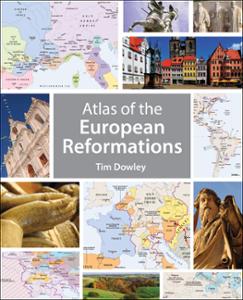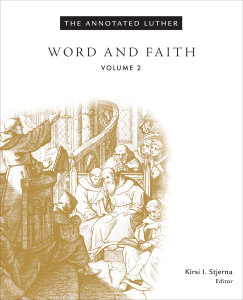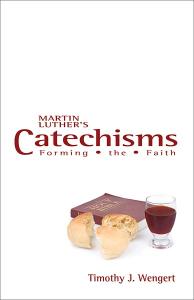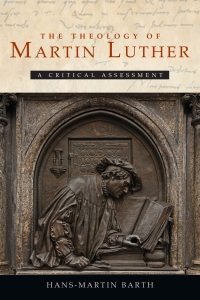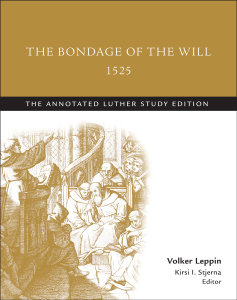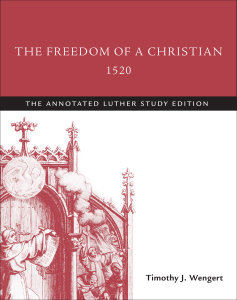-
Luther the Reformer: The Story of the Man and His Career
Engaging and authoritative, Kittleson's important and popular biography is here — represented with a new cover and new preface by the author. His...
$23.00
-
Atlas of the European Reformations
A new atlas of the European Reformations has been keenly needed. Fortress Press is pleased to offer the Atlas of the European Reformations.
$24.00
-
When Lightning Struck!: The Story of Martin Luther
In this fast-paced, action-packed novel of Martin Luther's life, Danika Cooley conveys both the drama and the meaning of the Reformation for younger readers like no one before her!
$24.00
-
The Annotated Luther, Volume 2: Word and Faith
Volume 2 of The Annotated Luther series contains a number of the writings categorized under the theme word and faith. Luther was particularly focused on what the word "does" in order to create and sustain faith.
$39.00
-
True Faith in the True God: An Introduction to Luther's Life and Thought, Revised and Expanded Edition
True Faith in the True God meets the deep need for a clear and concise introduction to the life and teachings of the great church reformer, Martin Luther.
$44.00
-
Treatise on Good Works: Luther Study Edition
Luther's transformational idea of justification by faith alone was often misunderstood and misrepresented in the early years of the Reformation. In 1520, with his...
$19.00
-
The Freedom of a Christian: Luther Study Edition
Perhaps no work of Martin Luther's so captures the revolutionary zeal and theological boldness of his vision as The Freedom of a Christian. Yet, it is not...
$22.00
-
On Christian Liberty
This timeless little classic communicates essential teachings of Martin Luther. The subject of Freedom is both timely and poignantly relevant today. For the...
$15.00
-
Three Treatises
Martin Luther posted his Ninety-five Theses on the church door at Wittenberg in 1517. In the three years that followed, Luther clarified and defended his...
$35.00
-
Martin Luther's Catechisms: Forming the Faith
Martin Luther's catechisms 3 the Small Catechism in 1528-29, and the Large Catechism in spring 1529 — responded in part to "the deplorable,...
$18.00
-
The Theology of Martin Luther: A Critical Assessment
Does Martin Luther have anything to say to us today? Nearly five-hundred years after the beginning of the Reformation, Hans-Martin Barth explores that question
...$39.00
-
Women of the Reformation: From Spain to Scandinavia
In this fascinating and concluding volume in his series on the contributions of women to the Reformation, celebrated historian Roland Bainton tells the stories...
$34.00
-
Women of the Reformation: In France and England
Marguerite of Navarre, Jeanne d'Albret, Catherine of Aragon, Catherine Parr, and Elizabeth I — these are a few of the courageous women who used their...
$34.00
-
Women of the Reformation: In Germany and Italy
In this first installment in celebrated historian Roland Bainton's Women of the Reformation trilogy, sixteen women who are usually lost behind familiar...
$34.00
-
The Imaginative World of the Reformation
In this small gem of Reformation research, Peter Matheson offers a rich view of the Reformation as it appeared in pamphlets and sermons, woodcuts and...
$26.00
-
The Annotated Luther, Volume 3: Church and Sacraments
Volume 3 of The Annotated Luther series presents five key writings that focus on Martin Luther's understanding of the gospel as it relates to church, sacraments, and worship. Included in the volume are: The Babylonian Captivity of the Church (1520); The German Mass and Order of the Liturgy (1526); That These Words of Christ, "This is my Body," etc., Still Stand Firm Against the Fanatics (1527); Concerning Rebaptism (1528), and On the Councils and the Church (1539).
$39.00
-
The Annotated Luther, Volume 4: Pastoral Writings
Volume 4 of The Annotated Luther series presents an array of Martin Luther’s writings related to pastoral work, including sermons, hymns, letters, writings on prayer and the Christian life, as well as his widely used Small Catechism.
$39.00
-
The Babylonian Captivity of the Church, 1520: The Annotated Luther Study Edition
In his The Babylonian Captivity of the Church, Martin Luther set forth a reconsideration of the sacramental Christian life that centered on the word. His thesis is that the papacy had distorted the sacraments with its own traditions and regulations, transforming them into a system of control and coercion.
$16.99
-
The Bondage of the Will, 1525 (abridged): The Annotated Luther Study Edition
In autumn 1525, Luther wrote The Bondage of the Will as a response to humanist and theologian Erasmus of Rotterdam, who had criticized Luther's teachings in the diatribe On Free Will. Luther's argument on the matter of the bound and free will poses a challenge and an invitation for constructive contemporary theology.
$25.00
-
The Freedom of a Christian, 1520: The Annotated Luther Study Edition
Timothy J. Wengert skillfully sheds light on Luther's popular treatise. As controversy concerning his writings grew, Luther wrote a reconciliation-minded letter to Pope Leo X (1475-1521). To this letter he appended a nonpolemical tract describing the heart of his beliefs, The Freedom of a Christian.
$19.99
[[{"fid":"366","view_mode":"default","fields":{"format":"default","field_file_image_alt_text[und][0][value]":"Luther preaching Christ","field_file_image_title_text[und][0][value]":"Luther preaching Christ"},"type":"media","link_text":null,"attributes":{"alt":"Luther preaching Christ","title":"Luther preaching Christ","height":612,"width":1600,"class":"media-element file-default"}}]]



